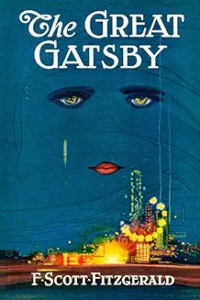The Great Gatsby by F. Scott Fitzgerald 1925
How does one say anything new about a novel that is widely regarded as ‘The Great Amerian Novel”, a book that remains Scribner’s best seller with more than 500,000 copies sold each year?
On the other hand, this is my third or fourth reading of Gatsby, and each time I learn something new and come away with a more nuanced view of Fitzgerald’s accomplishment. Published in 1925 after extensive revisions and a new title suggested by Scribner’s editor, Maxwell Perkins, the book was initially a critical and popular failure. Fitzgerald died in 1940 thinking his book would be forgotten, but a revival of interest occured in the ’40’s when the book was one of several chosen to be distributed to American GI’s in WWII. When Fitzgerald’s Princeton classmate, friend, and important literary influencer, Edmund Wilson praised the book, it gradually became a best seller and has entered the American canon as a classic. It is still widely read and assigned in most high school English classes.
The story is rich in themes. The book is narrated by Nick Carroway, a 30 year old Yale graduate and veteran of WWI, who has come to live in West Egg on Long Island as he begins his career as a bond salesman. His neighbor, the mysterious Jay Gatsby throws extravagant parties every weekend, and Nick is gradually drawn in to his world, a world of shady financial dealings with Meyer Wolfsheim (the not so subtle anti-semitism was troubling) and a world of complicated romantic attachments. Gatsby had met Daisy Buchanan in Louisville when he was a young army lieutenant. Despite not seeing her for five years while he was in the Army, he had remained obsessed with her, buying the West Egg mansion in order to be close to her mansion in East Egg which he nightly sought out via the ‘green light’ at the end of her pier. Obsession, love, the jazz age, murder, adultery, violence and greed are all mixed into this rich plot which ends badly for nearly everyone except the Buchanans who Fitzgerald characterized as “They were careless people, Tom and Daisy—they smashed up things and creatures and then retreated back into their money or their vast carelessness or whatever it was that kept them together, and let other people clean up the mess they had made.”
Fitzgerald’s writing is alternately beautiful and weird. Occasionally his adjectives feel strange and paragraphs that don’t make much sense are scattered through the book, but overall, the tragic story of Jimmy Gatz and Daisy Buchanan unfolds both beautifully and tragically. . Fitzgerald’s book came off copyright protection in 2021, and there were at least two Broadway productions, a new movie version, and a renewed interest in the novel. Having read this book several times now and enjoyed it more each time finding details that I had previously overlooked, I think I’m finally done with it. The Great American Novel…..I don’t think so. A spectacular novel about the Jazz Age, for sure, and one that ends with the memorable lines, “So we beat on, boats against the current, borne back ceaselessly into the past.”



